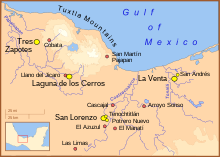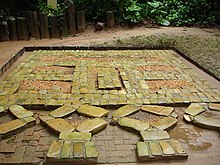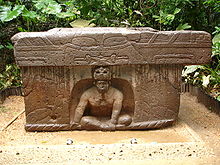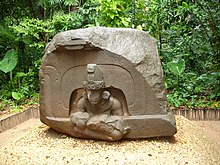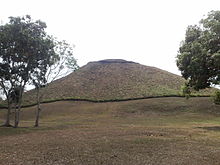La Venta (Mexico)
La Venta is an archaeological site in Mexico . It was a ceremonial center of the Olmec .
Locations
Historical
La Venta is the eponymous site of the La Venta culture, as the Olmec culture is also called. It grew out of an agricultural culture, whose beginnings from around 1500 BC. Are detectable. Although the urban Olmec culture initially had its focus in San Lorenzo Tenochtitlán and settlement layers in La Venta as early as 1200 BC. Chr., La Venta reached its real importance with the decline of San Lorenzo around 900 BC. The heyday of La Venta is with 800 to 400 BC. To apply.
The site has been largely destroyed by the construction of an oil refinery and an airfield (which has since been abandoned), as well as a settlement.
Geographically
La Venta is located on a small elevation in a marshland and river landscape of the Tonala in the heartland of the Olmec culture, which stretched on a 200-kilometer-long and 80-kilometer-wide strip along the coast of the Gulf of Mexico in the area of today's Mexican states Tabasco and Veracruz . La Venta itself is about 16 kilometers from the coast and presumably controlled the region between Rio Mezcalapa and Rio Coatzacoalcos . The built-up area covers approximately 2 km² and is oriented along a line that slopes eight degrees to the northwest. Not far is San Andres , which was evidently associated with La Venta as a residential area 2500 years ago. Laguna de los Cerros and Tres Zapotes are other important sites in the region that provided the basis for our knowledge of the first, now known, elaborate culture of Mesoamerica.
structure
La Venta is divided into several building complexes. The most important of these are A, B and C. Unlike the later Mayan buildings , La Venta's architecture was not made of solid stone, which is rarely found in the area, but of earth and clay. The basalt stones that were brought in from the Sierra de los Tuxtlas were used almost exclusively for "altars", steles and colossal statues. The basalt columns that surround complex A come from quarries near Punta Roca Partida near the San Andres Tuxtla volcano . The coloring of the inhabited area by colored layers of earth is also typical of the Olmec culture. In La Venta you can find red, green, blue, white, pink and purple ones.
Complex A
Complex A is located in the northern part of the archaeological site. Surrounded by basalt columns, there are places and embankments that hid a large number of buried objects. Mention should be made of votive masks , figurines, ceremonial axes and massive blocks of jadeite and serpentine . Complex A also includes three rectangular mosaics made of up to 485 serpentite stones. Each has a side length of almost 20 meters. The mosaics were interpreted as an abstract mask representation of a jaguar man , but also as an Olmec dragon, as a cosmogram or as a stylized map of La Venta. Obviously, the mosaics were not dedicated to observation, because shortly after their completion they were covered with several colored layers of earth. They were found eight meters below the surface. Furthermore, five graves, which are closely integrated into the overall architecture, belong to complex A. This led Diehl to assume that the entire complex A was used for the burial and commemoration of important rulers.
Complex B
South of the great pyramid (Complex C) is Complex B. It comprises elongated embankments and a space of around 350 by 80 meters. It may have served larger gatherings. The largest earthfill is on the eastern edge of the complex. It is named Stirling Acropolis in honor of Matthew Stirling , an archaeologist who systematically examined the site in the 1940s .
Complex C
Complex C contains one of the earliest known pyramids in Central America. It was 33 meters high and contained a volume of about 100,000 cubic meters, which was filled with earth. The current conical shape of the pyramid initially suggested that it might have been a representation of a volcano, but it could be shown that the pyramid originally had stepped sides and the current conical shape is a result of erosion. The pyramid itself has not yet been excavated. Magnetographic examinations, however, have revealed a noticeable finding on its southern edge that could indicate further offerings or a grave.
Most of the artifacts found in La Venta are now exhibited in the Archaeological Museum of Villahermosa ( Parque-Museo La Venta ).
literature
- Michael Coe, Dean Snow, Elizabeth Benson: Atlas of Ancient America. Facts on File, New York 1986, ISBN 0-86706-566-4 .
- Richard A. Diehl: The Olmecs. America's First Civilization. Thames & Hudson, London, 2004, ISBN 0-500-02119-8 .
- Rebecca Gonzalez-Lauck: La Venta (Tabasco, Mexico). In: Susan Evans (Ed.): Archeology of Ancient Mexico and Central America. Garland, New York 2001, ISBN 0-8153-0887-6 .
- Christopher Pool: Olmec Archeology and Early Mesoamerica. Cambridge University Press, Cambridge 2007, ISBN 978-0-521-78882-3 .
- F. Kent Reilly: Enclosed Ritual Spaces and the Watery Underworld in Formative Period Architecture: New Observations on the Function of La Venta Complex A. In: Virginia M. Fields (Ed.): Seventh Palenque Round Table, 1989. Pre-Columbian Art Research Institute, San Francisco 1994, pages 125-135.
- Christine Flon (Ed.): Picture Atlas of Archeology. Orbis, Munich 1991, ISBN 3-572-01022-5 .
See also
Web links
- Photos of Complex A (English)
- Sketch of complex A ( Memento from September 27, 2007 in the Internet Archive )
supporting documents
- ↑ Diehl: The Olmecs. America's First Civilization. Page 81
- ↑ Coe et al. a .: Atlas of Ancient America. Page 95
- ↑ Pictorial Atlas of Archeology. Page 344
- ↑ Diehl: The Olmecs. America's First Civilization. Page 73
- ^ A b Pool: Olmec Archeology and Early Mesoamerica. Page 161
- ↑ Reilly, pp. 125-135
- ↑ Diehl: The Olmecs. America's First Civilization. Page 70
- ^ Rebecca Gonzales-Lauck, quoted by Susan Evans: Archeology of Ancient Mexico and Central America.
Coordinates: 18 ° 6 ′ 19 ″ N , 94 ° 1 ′ 54 ″ W.
